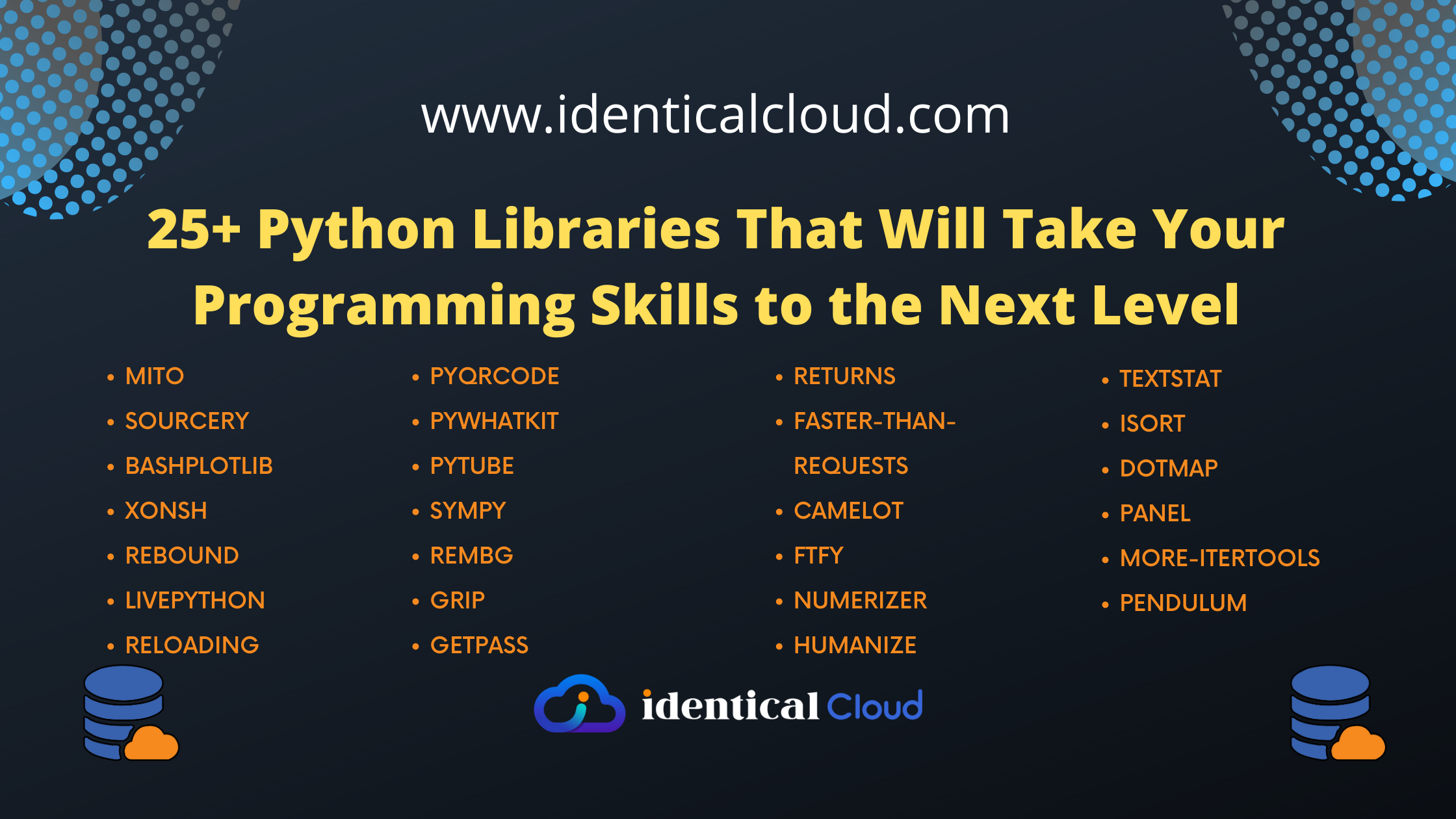
Hidden Gems: 25+ Python Libraries That Will Take Your Programming Skills to the Next Level
Hidden Gems: 25+ Python Libraries That Will Take Your Programming Skills to the Next Level
Python is a powerful programming language that is used for a wide variety of tasks. There are thousands of Python libraries available, but many of them are not well-known. In this blog post, I will share 25+ hidden gems that will take your programming skills to the next level.
These libraries cover a wide range of topics, including machine learning, data science, web development, and more. I have personally used all of these libraries, and I can attest to their quality.
If you are looking for ways to improve your Python skills, I encourage you to check out these hidden gems. They are sure to make your life easier and help you to take your programming to the next level.
Here are 25+ Python Libraries That Will Take Your Programming Skills to the Next Level.
1. Mito:
Mito is a Python library that helps you perform data preparation, data cleaning, transformation, exploratory data analysis, creating graphs, etc. with a few clicks. It is a spreadsheet for Python that can view Excel files, CSVs, and dataframes in an Excel-like interface. Mito uses a GUI to make it easy to perform data analysis tasks.
Here are some of the features of Mito:
- Data preparation: Mito can help you to prepare your data for analysis by cleaning it, transforming it, and merging it with other datasets.
- Data cleaning: Mito can help you to identify and remove errors from your data.
- Data transformation: Mito can help you to transform your data into a format that is easier to analyze.
- Exploratory data analysis: Mito can help you to explore your data and identify patterns.
- Creating graphs: Mito can help you to create graphs of your data.
Mito is a powerful tool that can help you to save time and effort when performing data analysis tasks. It is a great choice for beginners and experienced data analysts alike.
2. Sourcery:
Sourcery is a Python library that helps you to improve the quality of your code. It can automatically refactor your code, find potential bugs, and suggest improvements. Sourcery is a powerful tool that can help you to write better code faster.
Here are some of the features of Sourcery:
- Refactoring: Sourcery can automatically refactor your code to make it more concise, readable, and maintainable.
- Linting: Sourcery can find potential bugs in your code and suggest ways to fix them.
- Suggestions: Sourcery can suggest improvements to your code, such as using more idiomatic Python or adding comments.
Sourcery is a great tool for anyone who wants to improve the quality of their Python code. It is easy to use and can save you a lot of time and effort.
3. Bashplotlib:
Bashplotlib is a Python library that allows you to create simple plots in the command line. It is a lightweight library that is easy to use and can be used to create a variety of plots.
Here are some of the features of Bashplotlib:
- Simple to use: Bashplotlib is a very simple library to use. You can create a plot with just a few lines of code.
- Versatile: Bashplotlib can be used to create a variety of plots, including line plots, bar charts, and pie charts.
- Command-line: Bashplotlib is designed to be used in the command line. This makes it easy to integrate with other command-line tools.
Bashplotlib is a great tool for anyone who wants to create simple plots in the command line. It is easy to use and can be used to create a variety of plots.
4. Xonsh:
Xonsh is a Python library that provides a powerful and flexible command-line shell. It is designed to be a superset of Bash, so it can be used to run any Bash command. However, Xonsh also adds a number of features that make it more powerful and flexible, such as:
- Python scripting: Xonsh allows you to write Python scripts that can be used to automate tasks.
- Tab completion: Xonsh has intelligent tab completion that can help you to quickly find the commands and options that you need.
- History: Xonsh keeps a history of your commands, so you can easily repeat them or use them as inspiration for new commands.
- Plugins: Xonsh can be extended with plugins that add new features or functionality.
Xonsh is a great tool for anyone who wants to use Python to automate tasks or to make their command-line experience more powerful and flexible.
5. Rebound:
Sure. Rebound is a Python library that simulates the motion of N-body systems. It is a powerful tool that can be used to study a wide variety of systems, including planets, stars, and galaxies.
Here are some of the features of Rebound:
- N-body: Rebound can simulate the motion of N-body systems, where N can be any number.
- Symplectic: Rebound uses symplectic integrators, which are a type of numerical integrator that is designed to preserve the energy of the system.
- Extensible: Rebound is extensible, so you can add new features or functionality.
- Well-documented: Rebound is well-documented, so it is easy to learn how to use.
Rebound is a great tool for anyone who wants to simulate the motion of N-body systems. It is powerful, extensible, and well-documented.
6. Livepython:
Livepython is a Python library that allows you to run Python code in the browser. It is a powerful tool that can be used to teach Python, share code, and collaborate on projects.
Here are some of the features of Livepython:
- Run Python code in the browser: Livepython allows you to run Python code in the browser. This makes it easy to share code and collaborate on projects.
- Teach Python: Livepython can be used to teach Python. This is because it allows you to run Python code in the browser, which makes it easy for students to follow along.
- Share code: Livepython can be used to share code. This is because it allows you to create interactive notebooks that can be shared with others.
- Collaborate on projects: Livepython can be used to collaborate on projects. This is because it allows you to create shared notebooks that can be edited by multiple people at the same time.
Livepython is a great tool for anyone who wants to run Python code in the browser, teach Python, share code, or collaborate on projects.
7. Reloading:
The Python library Reloading allows you to reload modules and packages without having to restart your Python interpreter. This can be useful for debugging code, or for testing changes to your code without having to restart your entire application.
Here are some of the features of Reloading:
- Reload modules: Reloading allows you to reload modules that have been imported into your Python interpreter.
- Reload packages: Reloading also allows you to reload packages, which are collections of modules.
- Hot reloading: Reloading can be used to hot reload code, which means that you can reload code while your application is running.
- Well-documented: Reloading is well-documented, so it is easy to learn how to use.
Reloading is a great tool for anyone who wants to debug code, or for testing changes to their code without having to restart their entire application.
8. PyQRCode:
PyQRCode is a Python library that creates QR codes. QR codes are two-dimensional barcodes that can be scanned by smartphones and other devices. They are often used to store URLs, contact information, and other data.
Here are some of the features of PyQRCode:
- Create QR codes: PyQRCode can create QR codes that store a variety of data, including URLs, contact information, and text.
- Customize QR codes: PyQRCode allows you to customize QR codes, such as by changing the size, color, and error correction level.
- Save QR codes: PyQRCode can save QR codes as images or as text files.
- Well-documented: PyQRCode is well-documented, so it is easy to learn how to use.
PyQRCode is a great tool for anyone who wants to create QR codes. It is easy to use and can be used to create QR codes that store a variety of data.
9. PyWhatKit:
PyWhatKit is a Python library that allows you to send WhatsApp messages, get WhatsApp status, and more. It is a powerful tool that can be used to automate WhatsApp tasks.
Here are some of the features of PyWhatKit:
- Send WhatsApp messages: PyWhatKit can be used to send WhatsApp messages to individual contacts or groups.
- Get WhatsApp status: PyWhatKit can be used to get the status of a WhatsApp contact or group, such as their last seen, online status, and profile picture.
- Download WhatsApp status: PyWhatKit can be used to download the status of a WhatsApp contact or group, such as their photos, videos, and audio files.
- Automate WhatsApp tasks: PyWhatKit can be used to automate WhatsApp tasks, such as sending a message to a contact every day or getting the status of a group every hour.
- Well-documented: PyWhatKit is well-documented, so it is easy to learn how to use.
PyWhatKit is a great tool for anyone who wants to automate WhatsApp tasks. It is easy to use and can be used to send WhatsApp messages, get WhatsApp status, and more.
10. Pytube:
PyTube is a Python library that allows you to download YouTube videos and playlists. It is a powerful tool that can be used to download YouTube videos for offline viewing or to extract audio from YouTube videos.
Here are some of the features of PyTube:
- Download YouTube videos: PyTube can be used to download YouTube videos in a variety of formats, including MP4, WebM, and 3GP.
- Download YouTube playlists: PyTube can be used to download YouTube playlists in a single operation.
- Extract audio from YouTube videos: PyTube can be used to extract audio from YouTube videos in a variety of formats, including MP3, WAV, and FLAC.
- Well-documented: PyTube is well-documented, so it is easy to learn how to use.
PyTube is a great tool for anyone who wants to download YouTube videos or extract audio from YouTube videos. It is easy to use and can be used to download videos in a variety of formats.
11. SymPy:
SymPy is a Python library for symbolic mathematics. It provides a powerful and flexible way to manipulate mathematical expressions, solve equations, and perform symbolic computations.
Here are some of the features of SymPy:
- Manipulate mathematical expressions: SymPy can be used to manipulate mathematical expressions, such as adding, subtracting, multiplying, and dividing them.
- Solve equations: SymPy can be used to solve equations, both algebraic and differential equations.
- Perform symbolic computations: SymPy can be used to perform symbolic computations, such as finding the integral or derivative of a function.
- Well-documented: SymPy is well-documented, so it is easy to learn how to use.
SymPy is a great tool for anyone who wants to do symbolic mathematics in Python. It is easy to use and can be used to perform a variety of mathematical operations.
12. Rembg:
Sure. Rembg is a Python library that can be used to remove backgrounds from images. It is a powerful tool that can be used to create transparent backgrounds or to isolate objects from their backgrounds.
Here are some of the features of Rembg:
- Remove backgrounds: Rembg can be used to remove backgrounds from images in a variety of formats, including PNG, JPG, and GIF.
- Create transparent backgrounds: Rembg can be used to create transparent backgrounds, which can be used to create images that blend seamlessly with other backgrounds.
- Isolate objects from their backgrounds: Rembg can be used to isolate objects from their backgrounds, which can be used to create images that can be used in other applications, such as machine learning or computer vision.
- Well-documented: Rembg is well-documented, so it is easy to learn how to use.
Rembg is a great tool for anyone who wants to remove backgrounds from images or isolate objects from their backgrounds. It is easy to use and can be used to remove backgrounds from a variety of images.
13. Grip:
GRIP (Graph Representation Interchange Format) is a Python library that can be used to read and write GRIP files. GRIP files are a format for storing graph data, which is a type of data that represents relationships between entities.
Here are some of the features of GRIP:
- Read GRIP files: GRIP can be used to read GRIP files, which can be used to load graph data into Python.
- Write GRIP files: GRIP can be used to write GRIP files, which can be used to save graph data from Python.
- Support for a variety of graph formats: GRIP supports a variety of graph formats, including JSON, CSV, and XML.
- Well-documented: GRIP is well-documented, so it is easy to learn how to use.
GRIP is a great tool for anyone who wants to work with graph data in Python. It is easy to use and can be used to read and write GRIP files in a variety of formats.
14. getpass:
The Python library getpass is a built-in module that allows you to get a password from the user without echoing it to the screen. This is useful for security purposes, as it prevents other users from seeing the password as it is typed.
Here is an example of how to use the getpass module:
import getpass
password = getpass.getpass("Enter your password: ")This code will prompt the user to enter their password and will not echo the password to the screen. The password will be stored as a string in the variable password.
Here are some of the features of getpass:
- Get a password from the user without echoing it to the screen.
- Securely store the password.
- Well-documented: getpass is well-documented, so it is easy to learn how to use.
getpass is a great tool for anyone who wants to get a password from the user securely. It is easy to use and can be used to get passwords from users in a variety of applications.
15. returns:
The Python library returns is a third-party library that provides a way to handle errors and exceptions in a more explicit and predictable way. It does this by wrapping functions and returning a Result object, which can either be a Success object or a Failure object.
Here is an example of how to use the returns library:
import returns
def factorial(n):
if n < 0:
raise ValueError("n must be non-negative")
elif n == 0:
return returns.Success(1)
else:
return returns.Success(n * factorial(n - 1))
try:
result = factorial(-1)
except ValueError as e:
print(e)
else:
print(result)
This code will first try to call the factorial function with the argument -1. This will raise a ValueError exception, because -1 is not a non-negative number. The exception will be handled by the returns library and will be printed to the console.
If the factorial function was called with a valid argument, the result will be a Success object. This object can be inspected to get the value of the factorial.
Here are some of the features of returns:
- Handle errors and exceptions in a more explicit and predictable way.
- Provide a way to get the value of a function even if it raises an exception.
- Well-documented: returns is well-documented, so it is easy to learn how to use.
returns is a great tool for anyone who wants to handle errors and exceptions in a more explicit and predictable way. It is easy to use and can be used to handle errors and exceptions in a variety of applications.
16. faster-than-requests:
The Python library faster-than-requests is a third-party library that provides a faster alternative to the requests library. It does this by using a different underlying implementation that is more efficient.
Here are some of the features of faster-than-requests:
- Faster than requests: faster-than-requests is typically 2-3x faster than requests.
- Well-documented: faster-than-requests is well-documented, so it is easy to learn how to use.
faster-than-requests is a great tool for anyone who wants to make HTTP requests faster. It is easy to use and can be used to make HTTP requests in a variety of applications.
17. Camelot:
The Python library Camelot is a third-party library that can be used to extract tables from PDF documents. It does this by using a combination of optical character recognition (OCR) and heuristics.
Here are some of the features of Camelot:
- Extract tables from PDF documents: Camelot can extract tables from PDF documents in a variety of formats, including CSV, JSON, and XML.
- Configurable: Camelot is configurable, so you can customize the way that it extracts tables.
- Well-documented: Camelot is well-documented, so it is easy to learn how to use.
Camelot is a great tool for anyone who wants to extract tables from PDF documents. It is easy to use and can be used to extract tables from a variety of PDF documents.
18. Ftfy:
The Python library ftfy is a third-party library that can be used to fix common encoding and mojibake problems in text. It does this by using a variety of heuristics to identify and correct problems.
Here are some of the features of ftfy:
- Fix common encoding and mojibake problems: ftfy can fix a variety of encoding and mojibake problems, including:
- Encoding errors, such as characters that are not properly encoded.
- Mojibake, which is text that is garbled due to incorrect encoding.
- Configurable: ftfy is configurable, so you can customize the way that it fixes problems.
- Well-documented: ftfy is well-documented, so it is easy to learn how to use.
ftfy is a great tool for anyone who wants to fix encoding and mojibake problems in text. It is easy to use and can be used to fix problems in a variety of text.
19. Numerizer:
The Python library Numerizer is a third-party library that can be used to convert natural language numbers into their numeric equivalents. It does this by using a variety of heuristics to identify and extract numbers from text.
Here are some of the features of Numerizer:
- Convert natural language numbers into their numeric equivalents: Numerizer can convert a variety of natural language numbers into their numeric equivalents, including:
- Numbers written in words, such as “one hundred” and “two thousand.”
- Numbers written as numerals, such as “100” and “2000.”
- Numbers written in a variety of formats, such as “1.234” and “1,234.”
- Configurable: Numerizer is configurable, so you can customize the way that it converts numbers.
- Well-documented: Numerizer is well-documented, so it is easy to learn how to use.
Numerizer is a great tool for anyone who wants to convert natural language numbers into their numeric equivalents. It is easy to use and can be used to convert numbers in a variety of text.
20. Humanize:
The Python library Humanize is a third-party library that can be used to make numbers more human-readable. It does this by converting numbers into words, such as “one million” and “two billion.”
Here are some of the features of Humanize:
- Convert numbers into human-readable words: Humanize can convert a variety of numbers into human-readable words, including:
- Integers, such as 100 and 2000.
- Floating-point numbers, such as 1.234 and 5.678.
- Exponential numbers, such as 1e+10 and 1e-10.
- Configurable: Humanize is configurable, so you can customize the way that it converts numbers.
- Well-documented: Humanize is well-documented, so it is easy to learn how to use.
Humanize is a great tool for anyone who wants to make numbers more human-readable. It is easy to use and can be used to convert numbers in a variety of text.
21. textstat:
The Python library textstat is a third-party library that can be used to calculate a variety of statistics about text. It does this by using a variety of metrics, such as the number of words, the number of sentences, and the Flesch-Kincaid readability score.
Here are some of the features of textstat:
- Calculate a variety of statistics about text: textstat can calculate a variety of statistics about text, including:
- The number of words.
- The number of sentences.
- The average sentence length.
- The Flesch-Kincaid readability score.
- The Gunning Fog readability score.
- Configurable: textstat is configurable, so you can customize the way that it calculates statistics.
- Well-documented: textstat is well-documented, so it is easy to learn how to use.
textstat is a great tool for anyone who wants to calculate statistics about text. It is easy to use and can be used to calculate statistics in a variety of text.
22. isort:
The Python library isort is a third-party library that can be used to sort imports in Python code. It does this by using a variety of criteria, such as the length of the import name and the order in which the imports are declared.
Here are some of the features of isort:
- Sort imports in Python code: isort can sort imports in Python code in a variety of ways, including:
- Alphabetical order.
- Length-based order.
- Grouping by import type.
- Configurable: isort is configurable, so you can customize the way that it sorts imports.
- Well-documented: isort is well-documented, so it is easy to learn how to use.
isort is a great tool for anyone who wants to sort imports in Python code. It is easy to use and can be used to sort imports in a variety of code.
23. DotMap:
The Python library DotMap is a third-party library that can be used to create and manipulate Python dictionaries in a more intuitive way. It does this by using a dot notation syntax, which makes it easy to access and modify dictionary keys.
Here are some of the features of DotMap:
- Create and manipulate Python dictionaries in a more intuitive way: DotMap can be used to create and manipulate Python dictionaries in a more intuitive way by using a dot notation syntax. For example, you can access a dictionary key by simply using the dot notation, such as
my_dot_map.key_name. - Automatic hierarchy creation: DotMap can automatically create a hierarchy of dictionaries when you use the dot notation syntax. This makes it easy to access and modify nested dictionary keys.
- Well-documented: DotMap is well-documented, so it is easy to learn how to use.
DotMap is a great tool for anyone who wants to create and manipulate Python dictionaries in a more intuitive way. It is easy to use and can be used to create and manipulate dictionaries in a variety of ways.
24. Panel:
The Python library Panel is a third-party library that can be used to create interactive dashboards and web applications. It does this by using a variety of widgets, such as charts, tables, and sliders.
Here are some of the features of Panel:
- Create interactive dashboards and web applications: Panel can be used to create interactive dashboards and web applications by using a variety of widgets. For example, you can create a chart widget to visualize data or a table widget to display data in a tabular format.
- Flexible and customizable: Panel is flexible and customizable, so you can create dashboards and web applications that meet your specific needs.
- Well-documented: Panel is well-documented, so it is easy to learn how to use.
Panel is a great tool for anyone who wants to create interactive dashboards and web applications. It is easy to use and can be used to create dashboards and web applications in a variety of ways.
25. more-itertools:
The Python library more-itertools is a third-party library that provides a collection of functions that extend the functionality of the standard itertools library. It does this by providing functions that perform tasks such as:
- Combining iterators: more-itertools provides functions that can be used to combine iterators in a variety of ways. For example, you can use the chain() function to combine two iterators into a single iterator.
- Filtering iterators: more-itertools provides functions that can be used to filter iterators in a variety of ways. For example, you can use the dropwhile() function to filter an iterator so that it only returns elements that occur after a certain point.
- Transforming iterators: more-itertools provides functions that can be used to transform iterators in a variety of ways. For example, you can use the pairwise() function to create an iterator that returns pairs of consecutive elements from an iterator.
more-itertools is a great tool for anyone who wants to extend the functionality of the standard itertools library. It is easy to use and can be used to perform a variety of tasks.
26. Pendulum:
The Python library Pendulum is a third-party library that provides a more intuitive and easier-to-use interface for working with datetime information. It does this by providing a number of features, such as:
- A more intuitive API: Pendulum’s API is designed to be more intuitive and easier to use than the standard datetime library. For example, you can use the
now()function to get the current datetime, and thefrom_iso8601()function to create a datetime from an ISO 8601 string. - Support for different timezones: Pendulum supports different timezones, so you can easily work with datetimes in different time zones.
- A variety of formatting options: Pendulum provides a variety of formatting options, so you can easily format datetimes in a variety of ways.
Pendulum is a great tool for anyone who wants to work with datetime information in a more intuitive and easier-to-use way. It is easy to use and can be used to work with datetimes in a variety of ways.
I hope you enjoyed this blog post and found some new Python libraries to check out. If you have any questions or suggestions, please feel free to leave a comment below.
Thank you for reading!









